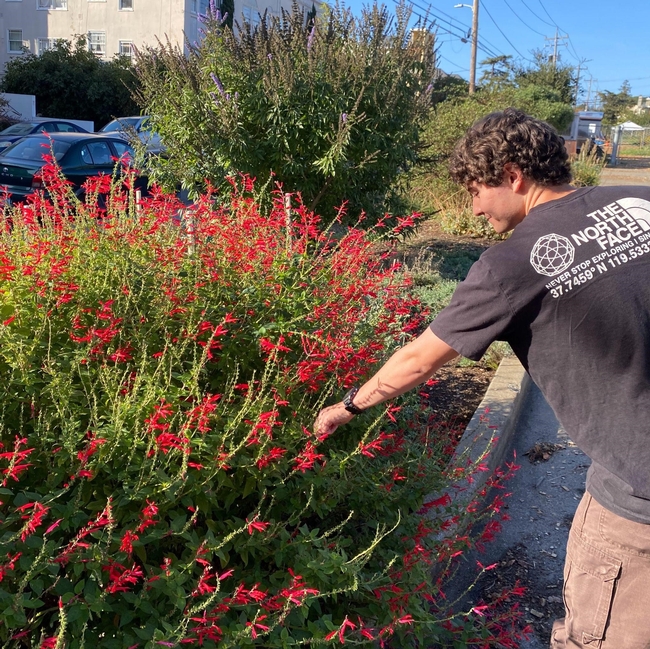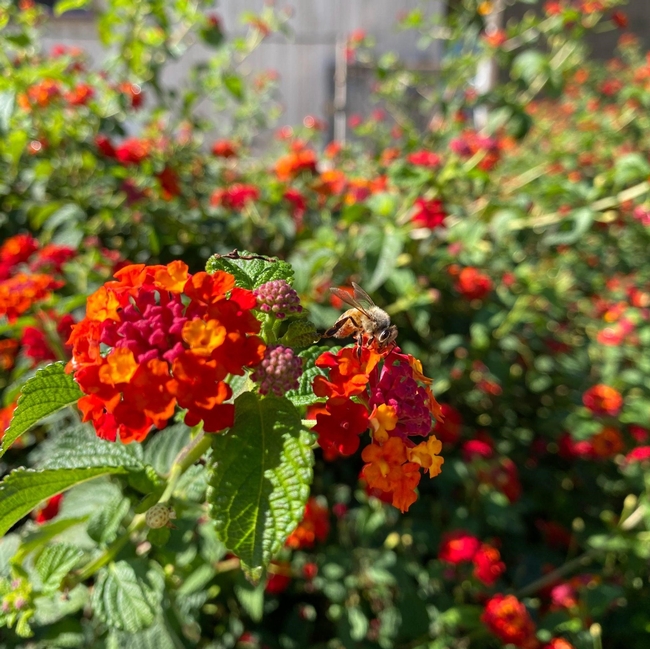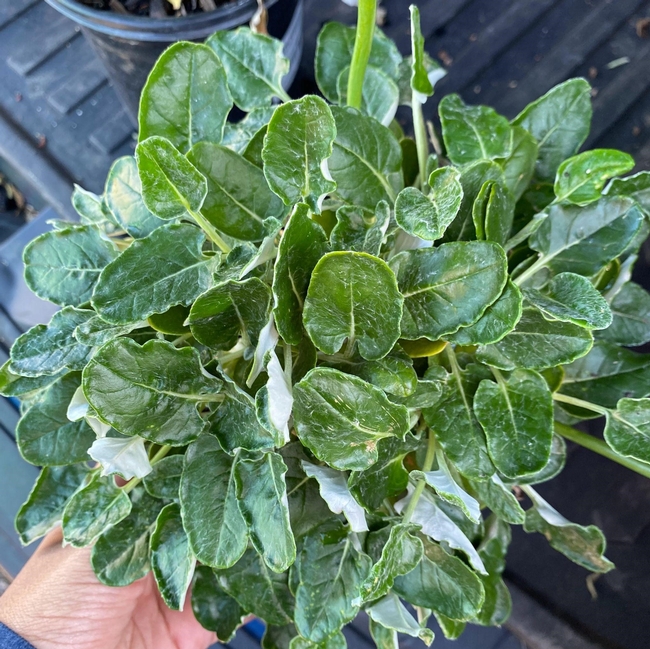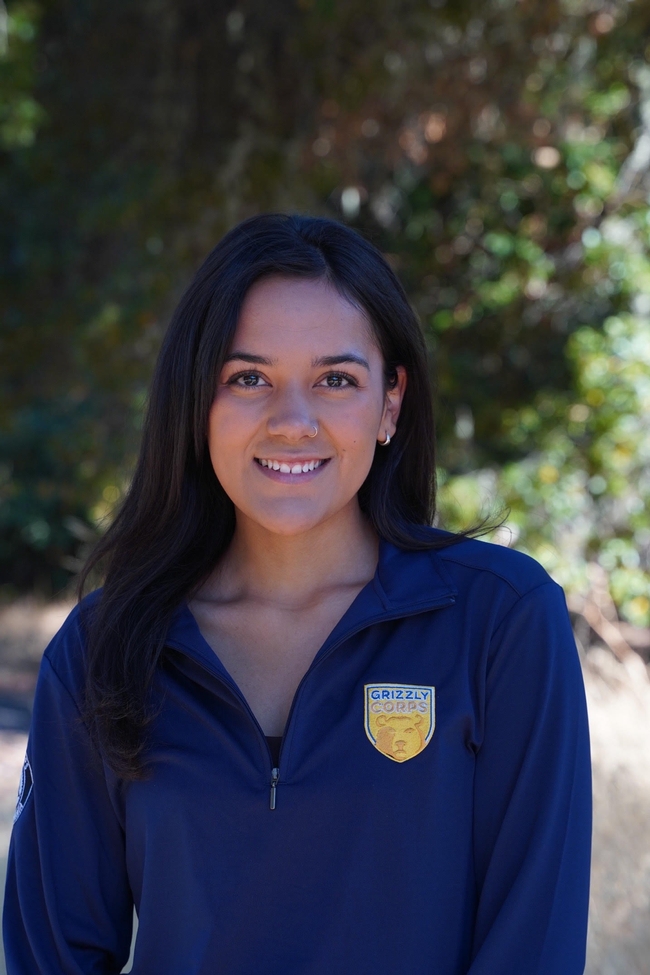- Author: Lily Elola
Rangeland Stewardship: Grazing for Ecosystem Resilience
Principal Investigators Dr. Valerie Eviner and Dr. Mary Cadenasso of UC Davis's Department of Plant Sciences have collaborated with the Hopland Research and Extension Center (HREC) to design a study that investigates the impacts of grazing and prescribed burning on plant communities and ecosystem services in California's grasslands. Using both permanent plots and more flexible adaptive management studies, their project aims to understand how different management practices can enhance the “building blocks of resilience” in these systems– features such as the wildflower seedbank and increased water storage in soi,l which are critical for sustaining California grasslands in the face of environmental challenges such as invasive species, droughts, and wildfires.
Dr. Valerie Eviner collecting data at the Hopland Research and Extension Center
Hopland, CA
In an interview with HREC, Ecosystem and Restoration Ecology professor Dr. Eviner shared insights on emerging trends and technologies poised to shape ecological research in the coming decade. She highlighted how recent advancements in statistical tools have significantly transformed ecological research by allowing researchers to better understand the complex connections within ecosystems. She also underscored the significance of satellite and drone imagery in providing a broader perspective of plant ecology. Dr. Eviner also emphasized that recent state legislation is facilitating the widespread use of prescribed burning, which “presents a unique opportunity to explore the role of fire in grassland ecosystems through controlled experiments”. Additionally, she emphasized the growing importance of community-engaged research and working with diverse communities to foster responsible stewardship of natural resources. She concluded by emphasizing that “while data production is important, it lacks context without the wisdom cultivated through long-term observations on the land, often through thoughtful natural resource stewardship.”
A persistent challenge in developing research that is useful to land managers and policy makers is that many experiments are limited in size and duration. “Partnering with HREC allows us to conduct long-term research at the management scale, which is often not feasible at other research sites.” Dr. Eviner highlighted. According to Dr. Eviner, HREC has demonstrated a “commitment to adaptive management research” that allows her research team to gain valuable insights into what ecological management practices work and which don't– and how that may change over time.
In Dr. Eviner's opinion, the most pressing environmental challenge facing the world today is extreme events like wildfire and drought. She argues that in order for ecological research to be effective, “Science has to contribute to explaining and preparing communities for events they've never seen before.” The best path forward is for scientists to work in collaboration with land managers and policymakers to identify challenges and gaps in our understanding, and prioritize research that addresses future scenarios”. She highlights the critical role of science in identifying the foundations of ecosystem resilience, advocating for practices like retaining dead plant material to bolster soil health and water retention. Dr. Eviner also prompts a reassessment of traditional management goals in light of evolving environmental conditions, suggesting a shift towards promoting root production and carbon sequestration in grazed pastures. Furthermore, she underscores the importance of organizations such as the California Climate and Agriculture Network, in informing climate change policies and mitigation strategies at the state level.
Dr. Eviner envisions that the insights from her ecological research can extend beyond academia, effectively influencing positive change among various audiences. She emphasizes the importance of tailoring communication strategies to different groups. For instance, she notes that when engaging with land managers, there's no need to elaborate on the unprecedented environmental challenges; they are already acutely aware. Instead, discussions can focus on pragmatic approaches for adaptation and resilience.
Rangeland at the Hopland Research and Extension Center
Hopland, CA
When communicating with the general public, Dr. Eviner draws inspiration from experts like Katharine Hayhoe, renowned for her series "Global Weirding." She's observed a significant shift in public perception over the past two decades, with many individuals now having firsthand experiences of climate-related disruptions, such as living through wildfire smoke. “Younger generations, in particular, are increasingly aware of these issues” Dr. Eviner notes. Teaching at UC Davis, Dr. Eviner notices a growing enthusiasm among students for addressing environmental challenges, evidenced by the burgeoning interest in fields like restoration ecology and ecosystem management. She highlights a remarkable growth in class sizes and a prevalence of waiting lists for courses focused on these topics.This quantifiable interest in the topic of land/ecosystem management is indicative of a surge in passionate individuals dedicated to finding solutions.
Dr. Eviner's personal values and perspectives play a significant role in shaping her research priorities. She emphasizes the importance of land grant universities, which not only focus on theoretical science but also prioritize practical research that enhances California agriculture and environment. Reflecting on her own journey into ecology, Dr. Eviner recalls that during her graduate studies, it seemed like there was a tough choice between a focus on research or community engagement , but that has changed due to trail blazers such as her Ph.D. advisor, Dr. F Stuart Chapin III, whose dedication to both research and community involvement left a lasting impression on her work.
While she acknowledges the value of big data, Dr. Eviner ultimately believes that her research stands out due to its “emphasis on hands-on experience under changing conditions”. Much like land managers who adapt their perspectives based on real-time observations, conducting research in dynamic environments requires a keen awareness that different players in an ecosystem may be important under different conditions- so that we have to be flexible in what we're measuring. As an example, she highlights that when measuring seed survival after the 2018 Mendocino wildfire, on-the-ground observations made it apparent that ants played a large role in collecting viable seeds and concentrating them into “islands of recovery” of grasses. Dr. Eviner stresses the importance of collaborating with land managers and leveraging local wisdom, recognizing that even if individuals don't agree on the explanations of how a system works, they can often agree on the observations that led to those explanations, providing valuable context and wisdom.
- Author: Lily Elola
Fungal-Bacterial Interactions: Bridging Soil Niches in Regulating Carbon and Nitrogen Processes
Grasslands play a vital role in the nutrient cycling process of both carbon and nitrogen. The state of California is home to perennial and annual grasslands, distinguished from one another by their growth patterns. Annual grasses complete their growth cycle in a single season, whereas perennial grasses exhibit persistent growth throughout the year. Perennial grasses often develop extensive root systems that provide a more stable mechanism for long term carbon storage than their annual counterparts. Historically, three disturbances contributed to the conversion of California's former native perennial grasses to its current annual-dominated status: European colonization, fire-suppression, and drought.
Oak-woodland adjacent annual grasslands here in Hopland offer a distinctive seasonal rhythm. The growth season of this grass begins when rainfall is hearty enough to germinate grass seeds, typically during the late fall/winter. While characterized by herbaceous vegetation, the structure of these grasslands depends greatly on local weather and livestock grazing patterns. Because the life cycle of annual grass is limited to a single growing season, there is less time for it to contribute to long-term carbon storage. This means that the nutrient cycling process in an annual grassland ecosystem is primarily the job of biotic reactions between fungi and bacteria below the surface of the grass, in its soil. The Hopland Research and Extension Center (HREC) and soil microbial ecologist Dr. Mengting “Maggie” Yuan from UC Berkeley's Firestone Lab have teamed up to better understand how these biotic interactions in soil are affected by reduced precipitation conditions associated with climate change.
Dr. Mengting “Maggie” Yuan in the UC Berkeley Firestone Lab
Oxford Tract, Berkeley CA
Dr. Yuan's interest in natural resources began when her family would spend time walking together outside. This time spent in nature inspired her to think about the complexities of a much smaller biotic world. What kind of systems contribute to the function of smaller microbial ecosystems? She asked herself. This curiosity eventually led her to study environmental engineering in university. In 2011, she earned her Bachelor's degree in Environmental Engineering from Tsinghua University in Beijing. After which, she moved to the United States to earn her Ph.D. in Microbiology from the University of Oklahoma in 2017.
In the world of ecology, specifically soil microbial ecology, there exists promising opportunities for innovation and scientific advancement. Dr. Yuan points out that there is no standardized model for measuring the Biological Fertility Index (BFI) of soil, because scientists don't understand on a fundamental level the heterogeneity of the soil. The analytical methods scientists use currently to measure soil fertility point more to a soil's habitat than its biotic function.
“A scoop of soil contains, on a more microscopic level, mineral surfaces and pore space” says Dr. Yuan. “It's important that future research considers the spatial difference instead of potential.” She admits that understanding soil on a spatial level is a challenging facet of soil microbial ecology. She calls this her “lifelong challenge.” Still, she hopes to work towards projects like these that create well defined frameworks for describing the probability of microbes to be able to interact with the environment and other microbes.
Fungal ingrowth cores, used to allow fungal hyphae into soil core samples
Oxford Tract, Berkeley CA
Spectrometer equipment, owned by Lawrence Livermore National Laboratory
Oxford Tract, Berkeley CA
When it comes to staying up to date with advancements in microbial soil ecology, Dr. Yuan relies on her undergraduate researchers just as much as her postdoctoral colleagues. She cites collaboration as the mechanism of understanding what's going on in both her scientific community, and the greater academic community at UC Berkeley. She loves talking to undergraduates one-on-one to get a better understanding of their struggles and motivations for pursuing a career in natural resource science. Dr. Yuan says that, from her personal experience at UC Berkeley, “Students nowadays have a more developed understanding of their passion for climate action” and “bring to the table a valuable skill set missing from current climate solutions”. She is optimistic that undergraduate eagerness to participate in climate action research is indicative of a larger generational interest.
It was collaboration, flexibility, and the opportunity to connect with people on a national scale that encouraged Dr. Yuan to work on projects like these at UC Berkeley. She feels grateful that working in academia has allowed her the freedom to try and pose solutions to some of the state's most complex natural resource issues. Her work on this project holds profound implications for agriculture, environmental sustainability, and our understanding of climate change adaptation. The study's relevance extends far beyond the confines of HREC, as its findings will offer valuable insights applicable to other annual grassland areas in California, ultimately guiding land conservation and management strategies all around the state.
- Author: Lily Elola, HREC GrizzlyCorps Fellow
The California Department of Food and Agriculture's Healthy Soil Program provides funding for on-farm initiatives aimed at implementing soil practices that reduce greenhouse gas emissions and enhance carbon storage. The UC Hopland Healthy Soils Project was created in collaboration with the Hopland Research and Extension Center (HREC) and undertaken by UC Berkeley's Dr. Gordon Frankie to assess the impact of various hedgerow plant species on pollinator diversity. Hedgerows typically consist of shrubs, trees, grasses, and flowering plants that offer various advantages to the surrounding farm ecosystem. These advantages include but are not limited to: weed control, windbreak, erosion control, improved air and water quality, biodiversity enhancement, and increased pollinator activity.
To measure the effect of the hedgerows on pollinator activity, Dr. Frankie and his team at the UC Berkeley Urban Bee Lab conduct bee surveys on both the treatment area (hedgerow) and the control area (weeds and grasses) four times a year during spring, summer, and fall. The ultimate objective of this project is to strike an ecological balance by selecting plant species that benefit a range of organisms such as bees, birds, butterflies, and others, while simultaneously mitigating greenhouse gas emissions and sequestering carbon in the farm soil.
Assistant Researcher Jerid Vega with Pineapple Sage (Salvia elegans) at the Urban Bee Lab Garden in Berkeley, CA
Dr. Frankie, with the UC Berkeley Department of Environmental Science, Policy, and Management, is an urban entomologist with over 25 years of experience focusing on the behavioral ecology and community organization of solitary bee species in specific environments within California and Costa Rica. Over the past two decades, Dr. Frankie has conducted extensive studies on bee diversity, seasonality, and host plant preferences at various sites in northern California and seasonal dry forests in Costa Rica. His research also involves monitoring changes in annual bee frequencies and mortality factors that may impact bee populations. Recently, Dr. Frankie's work has shifted from pure wildland studies to comparative bee studies in both wildlands and urban residential gardens, driven by the discovery that urban areas can support diverse local bee species. This shift aligns with a broader concern of global pollinator decline and the need to find new ways to conserve and protect pollinators across different habitats.
A pollinator visiting Lantana or Shrub Verbena (Lantana camara) at the Urban Bee Lab Garden in Berkeley, CA
Dr. Frankie and his assistant researcher Jerid Vega recently stopped by HREC to add herbaceous plants and flower seeds to their project's test hedgerow. Jerid graduated from Berkeley in the spring of 2023 with a B.S. in Molecular Biology from UC Berkeley's College of Natural Resources. Both Dr. Frankie and Jerid argue there is inherent value in recognizing what biodiversity is. “Supporting that biodiversity can be achieved through investments in smaller, more pollinator friendly gardens” says Vega.
Admittedly, Dr. Frankie acknowledges that picking plants for the hedgerow and observing their relationships with pollinator visitors is a very slow process. The time it takes for plant species to establish can be an obstacle to speedy species surveying. When asked how their research team selects and manages the plant species for a specific project, Dr. Frankie and Jerid credit nursery workers, master gardeners, and community members for their suggestions. Dr. Frankie's ideology on plant selection is collective, the product of conversation about pollinator activity from his team, colleagues, and master gardeners. “Those are the people who spend time with the plants, watching them far more than I do!” Dr. Frankie chimes.
Urban Bee Lab Garden in Berkeley, CA
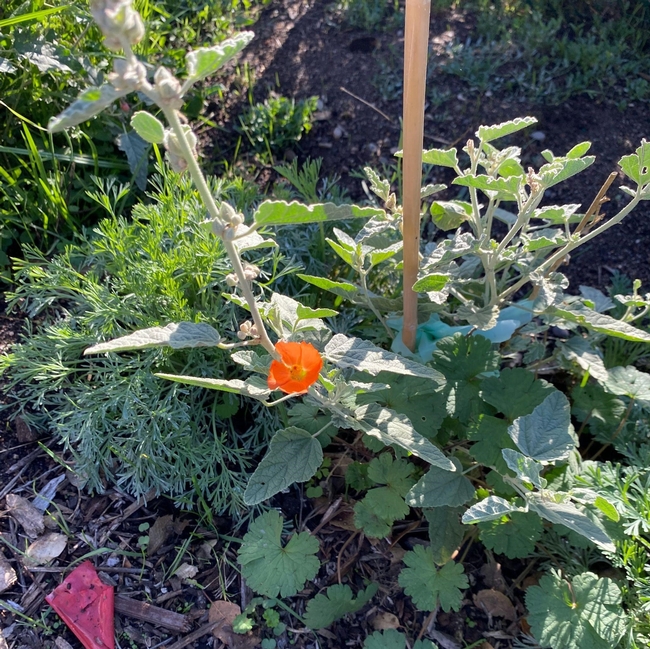
The Desert Mallow and native Redflower Buckwheat (pictured below) are just two of the many plant species that Dr. Frankie and his research team are in the process of observing. These native wildflowers not only produce striking, colorful blooms but also offer a wealth of nectar and pollen, making them a valuable food source for bees, butterflies, and other beneficial insects. Their extended blooming periods, typically from spring through late summer, ensure a consistent supply of sustenance for pollinators throughout the season. Additionally, both plants are well-adapted to arid and semi-arid regions, making them resilient and low-maintenance choices for gardeners. The Desert Mallow and Redflower Buckwheat exemplify the harmonious relationship between native plants and their pollinator counterparts that enhances biodiversity and contributes to a healthier ecosystem.
It's important to recognize that these pretty flowers attract all kinds of insects that aren't as suitable to some as the docile hummingbird. “It's not just bumble bees that these plants attract, it's wasps and flies that do their own part in benefiting ecosystem biodiversity,” adds Jerid Vega. The myth of insect pollinators being inherently eager to sting humans can be a significant obstacle in the way of convincing people to plant pollinator-friendly gardens. This fear of insects perpetuates reluctance to support both wildland and urban insect populations. In reality, these insects are not naturally aggressive toward people. “They're primarily focused on foraging for nectar/pollen to feed their colonies, and will only sting as a last resort if they feel threatened or cornered” concludes Jerid.
Educating people about the behavior and importance of bees and other pollinators is crucial. Dispelling the myth that bees are out to sting us can encourage more individuals to embrace pollinator-attracting plants, contributing to the conservation of these vital species. Understanding the true nature of bees and their role in pollination can lead to a more harmonious coexistence between humans and these remarkable insects.
When asked what potential small gardens with pollinator-preferred species have to attract a high diversity of bee species, Dr. Frankie provided some examples of encouraging results starting with his lab at the Oxford Tract. When the Bee Lab first moved to this site off campus, they started with bare soil. Since moving there full time in 2020, the garden has attracted over sixty species of native bees. The Bee Lab has also consulted on community gardens outside of the Bay Area in the past, including Emerson Community Garden in San Luis Obispo and a Diverse Home Garden in Ukiah. Emerson Community Garden surveyed 5 native bee species pre-planting and 42 species post-establishment. Diverse Home Garden in Ukiah surpassed that of Emerson, surveying 65 bee species in total over the course of 12 years.
The Bee Lab does their work with the help of community educators and a select group of volunteers primarily composed of undergraduate students interested in entomology, resource studies, or environmental conservation. Dr. Frankie's team sifts through volunteer applications annually, and are attracted to students they know will stay on board and have an interest in community outreach. Despite The Bee Lab being a small non-profit entity, they still respond to any invitations they can asking for lessons about pollinator vs. plant relationships.
Learn more about the UC Berkeley Bee Lab here.
This project was supported by funding through the CDFA's Healthy Soils Demonstration Program and 'California Climate Investments'. The HREC Hedgerow Demonstration Project is part of California Climate Investments, a statewide initiative that puts billions of Cap-and-Trade dollars to work reducing greenhouse gas emissions, strengthening the economy, and improving public health and the environment - particularly in disadvantaged communities.
- Author: Hannah Bird
- Author: Lily Elola
My name is Lily (she/her) and I'll be working as a Climate Resiliency Fellow for the Hopland Research and Extension Center through July 2024. My position was made possible through GrizzlyCrops, an AmeriCorps program operated through UC Berkeley's Center for Law, Energy and the Environment. I grew up in the East Bay, after which I moved to San Luis Obispo where I got my B.S. in Environmental Management and Protection at Cal Poly. The first couple years of my undergraduate education I worked as an application aid for Calfresh, federally known as the Supplemental Nutrition Assistance Program (SNAP). After that, I worked as a researcher on two different projects under the supervision of Cal Poly's Natural Resource and Environmental Science Department. One project created a triangulated methodology for managing sustainable consumer experience using eye-tracking and biometric data collection. The other evaluated nitrogen mineralization rates of various organic fertilizers in order to better inform sustainable agricultural operations. In the spring of 2023 I received a grant from Cal Poly's Natural Resource and Environmental Science Department to host the LEAD Scholars Talk. Exhibit, an on-campus event showcasing the voices and experiences of black, indigenous, and queer environmental activists/industry professionals.
My work at the HREC in the coming year aims to: (1) Increase community preparedness and resilience to extreme weather and climate change, (2) Improve access to natural environments, (3) Increase diversity, inclusiveness and cultural competence in environmental education, and (4) Increase youth awareness of natural resource and agricultural systems, issues, and solutions. I'll be working with community educator Hannah Bird to develop and deliver environmental education programs to K-12 students about the importance of ecosystem management, fire science, rangeland conservation, and natural resource ecology.
I consider the ability to foster a meaningful relationship with Earth's natural resources an immense privilege! I'm excited to share what I have learned with the HREC and the greater community it serves.
Learn more about how the GrizzlyCorps program works to promote regenerative agri-food systems and fire and forest resilience around the state of California here.
- Author: Hannah Bird
|
|
|

